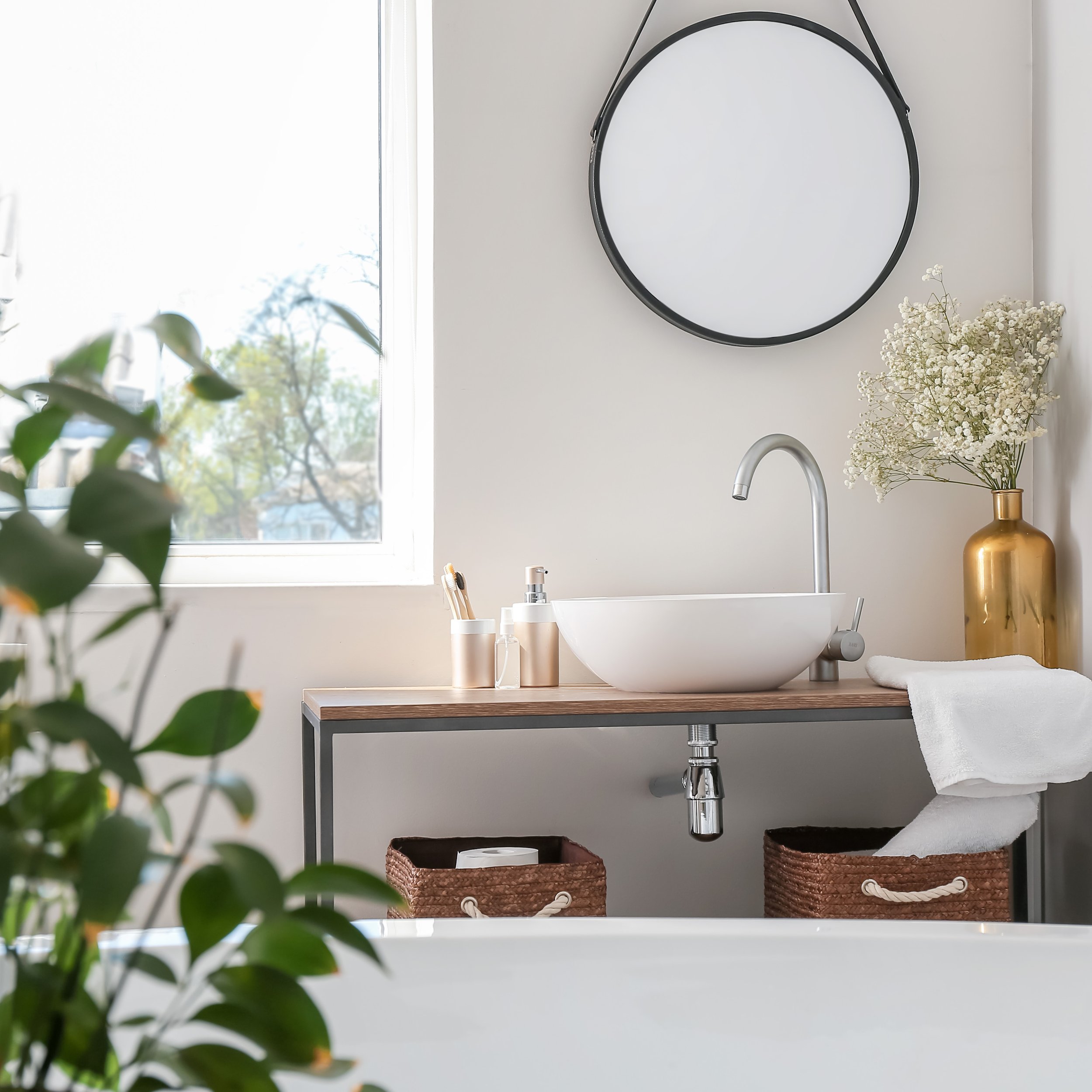The Best Type of Paint for Bathrooms
Give your bathroom a boost with a fresh coat of paint. Whether you want to create a serene spa experience or a bright space to start your day off right, you can reinvent your bathroom with the right shade and finish of paint.
When planning to paint your bathroom, remember to take into account the damp and sometimes humid conditions that may exist. Hot showers and sink splashes can lead to moisture on the walls and the paint you choose needs to be able to stand up to these conditions and resist mildew growth—a common problem in bathrooms.
Oil Paint vs. Latex Paint
If you’re looking for the right type of paint for your bathroom, reach for a water-based latex paint. While oil paint has its reputation for durability and ability to stand up to scrubbing—much needed qualities in paint for bathrooms—it requires the use of mineral spirits for clean-up, dries slowly between coats, and releases high levels of volatile organic compounds (VOCs). There’s also the chance that oil paint will yellow over time, especially in low light conditions.
Latex paint is a better pick for bathrooms and many formulas today offer much-improved durability and moisture resistance. Just be sure that if you opt for water-based latex paint, you pick a paint that is washable. These paints will typically have a tighter molecular structure that doesn’t allow water to penetrate, meaning you can scrub away stains and residue without worrying about moisture from your cleaning efforts ruining your paint.
When planning a bathroom makeover, do yourself a favor and go with easier-to-use and quicker-to-dry latex paint. You can clean up brushes and spills with water, and you’ll breathe easier in the small space when using a low VOC paint
The Best Finish for Bathrooms
Picking the right finish for bathroom paint is a crucial part of ensuring that your painting project meets with success. The finish of the paint, or how shiny it is, might seem like an aesthetic decision only, but it’s really a matter of how durable and mold-resistant your bathroom walls will be.
Flat paints have more pigment particles and less resin and binders. As a result, these paints have a rich color and low luster, but are more prone to moisture infiltration. Additionally, they don’t stand up to scrubbing and it can be tough to clean walls with flat paint without affecting the finish. For these reasons, it’s best to pass on a flat finish paint for bathrooms.
The exception would be a paint made for bathrooms specifically. If you opt for one of these mildew-resistant and more durable paints, you may be able to get away with a flat finish in the more humid conditions of a bathroom. These paints usually carry a premium price and we wouldn’t recommend them over regular latex paint unless you have your heart set on a flat finish paint in the bathroom.
The best finish for a bathroom paint is semi-gloss or gloss. Semi-gloss paint is shiny and holds up to cleaning well, however it can highlight imperfections on your walls. Both options will give you a finish with some shine that helps the paint resist absorbing extra moisture that leads to mildew growth.
Semi-gloss paint includes more resin and binders when compared to flat paint, and a glossy finish bumps up the amount of resins even more. As a result, you get a very tight molecular structure in these paint formulas. This is important when painting a bathroom for two reasons:
The paint will repel moisture. Rather than absorbing moisture and giving it a chance to collect and develop into mildew and mold, a wall painted with semi-gloss or glossy paint is more likely to see moisture evaporate away.
The tougher formula is better for washing and scrubbing. No doubt you like to keep your bathroom clean. A semi-gloss or glossy paint finish will hold up to your efforts to clean and sanitize your bathroom with less wear and tear on your paint.
Best Paint for Bathroom Ceilings
Look up—your bathroom ceiling is due for a fresh coat of paint, too. While you might be tempted to go for a cheap and quick coat of flat white, the best paint for bathroom ceilings is one that will resist moisture and mildew.
Pick a satin or semi-gloss paint finish for your bathroom ceilings. If you have a half-bath with low moisture and humidity, you can opt for the satin finish if you don’t want to draw too much attention overhead.
However, if you love a steamy shower and have a humid bathroom, then you’ll need to opt for a more durable and moisture-resistant semi-gloss finish. Often, you’ll see water spots on the ceiling from moisture condensing in this humid part of the house, and semi-gloss paint does a better job at preventing the growth of mildew and mold.
FYI
Never just paint over mildew growth. Before painting your bathroom, you must take steps to remove the mildew and seal it to prevent future growth and problems.
The typical method is to use a bleach and water solution to scrub the existing mildew from the walls and ceiling. Be sure that you wear a respirator and gloves during this process and keep the room well-ventilated. Then use a quality mildew-resistant primer, such as Zinsser Mold Killing Primer before moving onto paint application.
** This article was originally published by The Spruce. CLICK HERE to view the full article.
